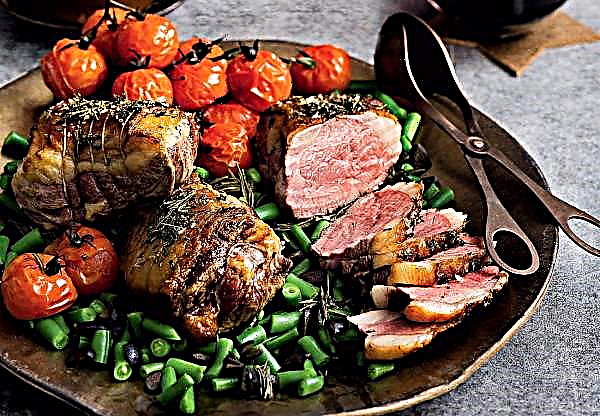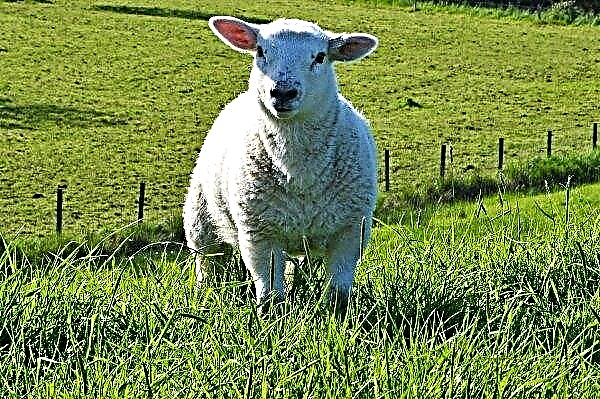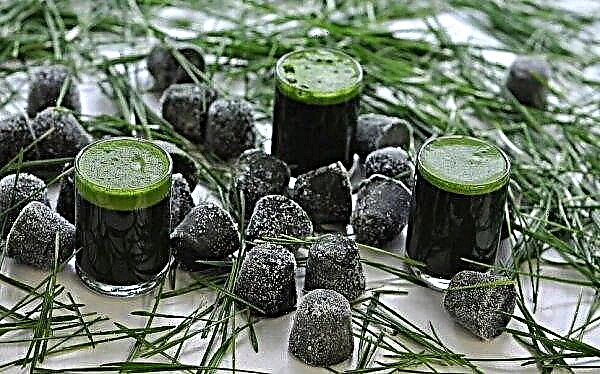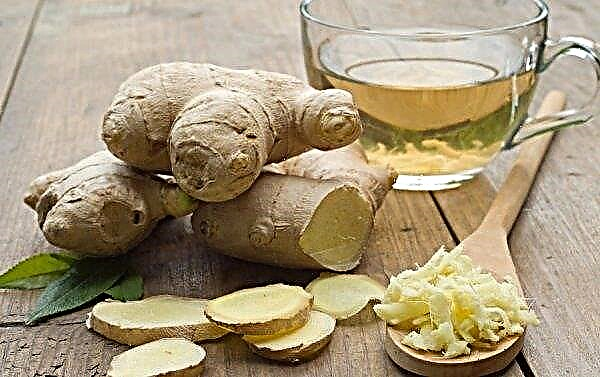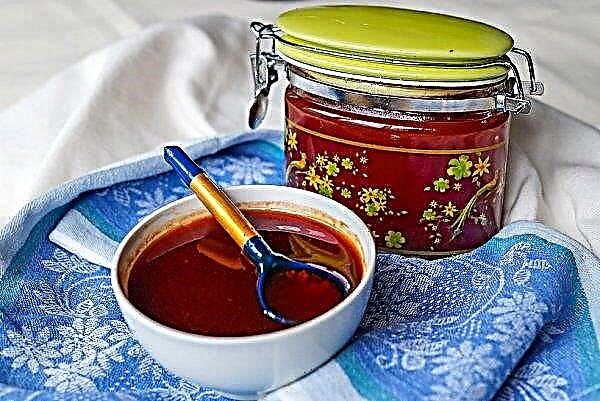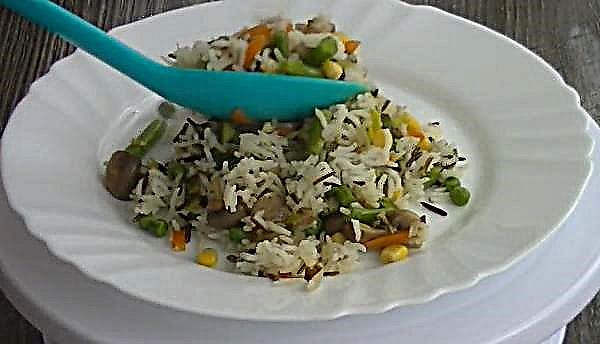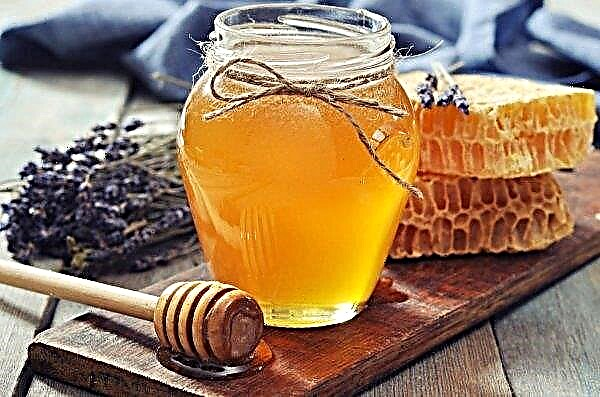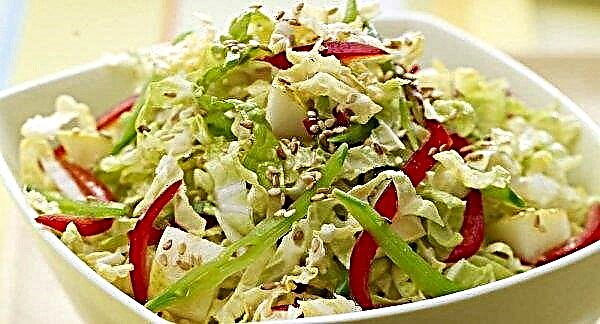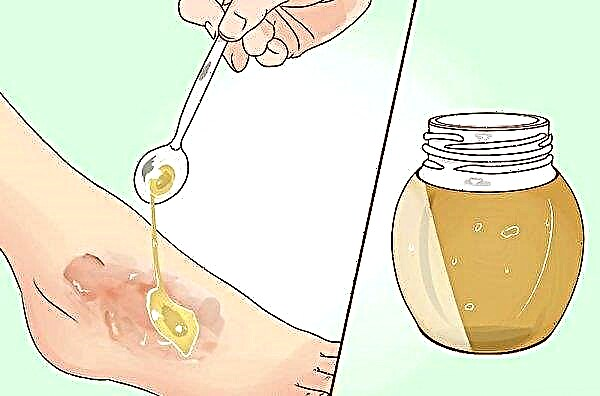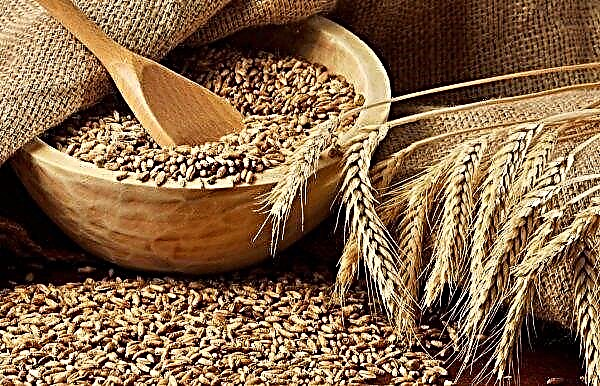Even in ancient times, observing celestial bodies, people deduced a certain pattern of planting and planting and the influence of lunar cycles on their development. Today, such dependence is proved by experts and the practice of gardening. The article will help determine the work on the infield in 2019 for the Moscow Region in accordance with the lunar calendar.
Lunar sowing calendar for 2019 for the Moscow region for months
The climate of the Moscow region and the Moscow region is characterized as temperate continental. Winters are fairly mild and summers are warm and humid. The coldest month is January (-10 ° С ... -15 ° С), and the warmest is July and the beginning of August (+ 18 ° С ... + 25 ° С).
Did you know? The temperature on the invisible night surface of the moon turned out to be unexpectedly low for researchers - -190 ° C. And the sunny side of our satellite is heating up to + 127 ° С.
Any plant has its own development cycle associated with the phases of the moon. So, for example, on the growing moon, the aerial parts of plants are more actively developing, the green mass is growing. With decreasing - the growth of the roots and the underground part of plants increases.
But do not forget that the strength and health of plants depends on proper care and ensuring all growing conditions. In addition, sometimes the weather and weather forecasts make adjustments to the organization of work on the garden plot.

Below are all suitable days for sowing and planting. Of course, no one will sow in the winter months, January or December, in an open area. But if the farm has year-round greenhouses, then such information may come in handy.
January
The month of January gives a little respite to gardeners and gardeners. But this time should be spent with benefit for further field work. Make a small phased plan for conducting spring field work - after all, this is the hottest time. Draw a rough plan of the site and outline the places for sowing and planting garden crops. So you can correctly take into account crop rotation and the permissible proximity of plants.
 The layout of garden crops looks something like this
The layout of garden crops looks something like this
Divide the plot conditionally into four parts, taking into account the requirements of garden crops for top dressing:
- organic fertilizers - early and late cabbage, asparagus, cucumbers, pumpkin, tomatoes;
- mineral fertilizers - carrots, beets, celery, parsley, radish;
- crops that do not require fertilizers - onions, garlic, radishes, herbs, leafy vegetables;
- under potatoes and other garden plants at will.
Conduct an audit of planting and sowing material to remove expired seeds and plan the purchase of new varieties. If it is possible to visit the site in January, remove excess snow from the paths and walkways. Sprinkle with snow mass the beds with winter crops in case of exposure.
In January, you can sow seeds for seedlings for greenhouse cultivation:
| Culture | the date |
| cucumbers | 1, 19, 20, 28, 29 |
| pepper | 9–11, 13–15, 19, 20, 24, 28, 29 |
| cabbage | 1, 5–7, 19–21, 24, 25, 28, 29 |
| eggplant | 9–15, 20, 25, 28, 29 |
February
Springtime is approaching, the days are longer, sometimes the sun pleases with its appearance. It's time to do the sowing work in accordance with the lunar calendar. We advise you to keep it in a prominent place to regularly check the dates of sowing.
Check onion and garlic heads set aside for storage. Those specimens that showed green sprouts, plant tightly in seedlings for early vitamin green.

In early February, sown root and petiole celery, parsnip, root parsley for seedlings. Throughout the month, you should choose days for sowing cucumbers. To get early greens at home, you can sow leaf parsley, basil and plant onion heads on a feather.
In the last days of February, seeds of early ripe varieties of tomatoes, cucumbers, cabbage (white, cauliflower, broccoli), sweet pepper and eggplant are sown on seedlings on a growing moon. It should be borne in mind that usually the age of seedlings for planting in open ground should be 50-60 days.
Take a closer look

There is still not enough sunlight and heat in February, so a place for seedlings is chosen on a well-lit window sill or illuminated with phytolamps.
The cool February weather is suitable for cabbage seedlings and onion seedlings. Onion seedlings grow slowly and, when spring planted in open ground, take root more quickly, which is an advantage over crops immediately into the ground.
On a waning moon, one should dive. On the site, you can continue work on snow retention, check the thickness of the snow cover in winter crops on the beds.
In case of warm weather, remove mulch from the beds so that crops are not ripened.
Sowing days in February:
| Culture | the date |
| cucumbers | 7, 8, 11–13, 16, 17, 24, 25 |
| tomatoes | 1–3, 7, 8, 11–13, 16, 17, 24, 25 |
| eggplant | 1–3, 7, 8, 11–13, 16, 17, 24, 25 |
| radish | 1–3, 22–25, 28 |
| Sweet pepper | 1–3, 7, 8, 11–13, 16, 17, 24, 25 |
| different greens | 7, 8, 11, 12, 16, 17, 24, 25 |
| hot pepper | 9, 10, 16, 17 |
| cabbage | 7, 8, 11–13, 16, 17 |
March
The first thawed spots appear, migratory birds arrive. Spring in the suburbs usually comes in late March or early April. The active phase of field work is beginning. It is during this period that the foundation for the future crop is laid. Seedlings planted in February should be transplanted into the greenhouse or hardened on a glass balcony at a temperature of + 7 ° С ... + 10 ° С.

For the Moscow Region in mid-March, it is time to sow mid-season and late tomato varieties for seedlings, and you can continue in early April. In early March, 1, 2, you can sow parsley, celery and leek on seedlings. Put potatoes from storage for heating and germination.
If the weather permits, you can sow early vegetables - radishes, lettuce, sorrel, spinach and greens (parsley, dill).
Desired sowing days in March:
| Culture | the date |
| bow | 1, 2, 22–30 |
| cucumbers | 5, 20, 21, 24, 25 |
| eggplant | 5, 6, 15, 20, 21, 24, 25; |
| pepper | 5, 6, 10, 11, 20, 21, 24, 25 |
| cabbage | 10, 11, 15, 20, 21, 24, 25 |
| tomatoes | 5–7, 15, 20, 21, 24, 25 |
| radish | 5–7, 10–12, 15 |
| different greens | 5–12, 15, 20, 21 |
April
In Moscow suburbs, snow cover is falling in April, there are more sunny and clear days, spring primroses, coltsfoot are blooming, the first flowers appear on bird cherry.

Many gardeners are guided by folk signs, according to which onions are planted in open ground during the flowering of bird cherry or three weeks after the flowering of coltsfoot.
Spring suffering is in full swing. In the south of the region, under favorable weather conditions, seeds can be sown in open areas with temporary shelter.
By checking the lunar calendar, you can select the days in April for sowing seed:
| Culture | the date |
| cabbage | 7, 8, 11–13, 17, 18 |
| tomatoes | 8–11, 20, 21, 27–29 |
| bow | 20, 21–26, 29, 30 |
| cucumbers | 2, 3, 20, 21, 24–26, 29 |
| eggplant | 20, 21, 27–29 |
| pepper | 20, 21, 27–29 |
| garlic | 2, 3, 6–8,11–13 |
| radish | 1–3, 6–8, 11–13 |
| potatoes | 2, 3, 6–8, 11–13, 29 |
| carrot | 2, 3, 6–8, 11–13 |
| greenery | 2, 3, 11–13, 20, 21, 27–29 |
May
In May, a real spring arrives in the Moscow Region. The air warms up to + 16 ° C, greens bloom on the trees, many plants bloom. But it should be remembered that in May frost on the soil is still possible. You should take care of the first shoots and in time to cover them from the cold.

May is rightly considered the most stressful month in the organization of work on the garden plot. It's time for planting and sowing heat-loving garden crops, protection from pests and diseases, feeding and watering.
For the middle lane and Moscow region, the favorable sowing dates are as follows:
| Culture | the date |
| early cabbage | 6, 9, 10, 15–18 |
| middle and late | 18, 19, 24–28 |
| bow | 1, 4, 20–23, 26–28, 30 |
| cucumbers | 6, 9, 10, 11, 18, 19, 24–28 |
| eggplant | 4–6, 18, 19, 24–28 |
| pepper | 4–6, 18, 19, 27, 28 |
| garlic | 1, 4–6, 18, 19 |
| tomatoes | 4–6, 18, 19, 24–28 |
| radish | 1, 2, 4–6, 9–11 |
| potatoes | 1, 4–6, 9–11, 18, 19, 24–28 |
| carrot | 1, 4–6, 9–11, 24–26 |
| greenery | 1, 9–11, 18, 19, 24–28 |
June
The first summer month in the suburbs is usually warm (up to + 20 ° С). Sometimes there is a return to cooling and lingering rains, but frosts on the soil no longer exist. Work in the garden should be checked with weather forecasts.
In June, you can continue sowing heat-loving crops, plant flowers. It's time to harvest early ripe garden crops (sorrel, parsley, radish), herbs and berries.

Some gardeners are trying to finish sowing before the Holy Trinity Day, which will be June 16, 2019. It is believed that sowing after this period will lead to lush flowering of plants, but the crop as a whole will be poor.
In June, seedlings of late cabbage and tomatoes are planted in open ground, it is advisable to pick off the first flowers on cucumbers so that the whips gain strength and good growth, and the necessary pinching is carried out.
At the end of the month, you can re-sow carrots, radishes, lettuce, spinach, dill and precocious vegetables. The second dill crop will provide fresh greens with massive vegetable harvests at the end of summer of cucumbers and other vegetables, when the first crop of greens has already ended.
Recommended boarding days in June:
| Culture | the date |
| cabbage | 5, 6, 11–16 |
| bow | 1,2, 18–20, 23–25, 27–30 |
| cucumbers | 3–5, 10, 11, 15, 23, 24 |
| eggplant, pepper | 15, 21–24 |
| garlic | 1–5, 10, 11 |
| bean | 6–15 |
| tomatoes | 15, 21–24 |
| squash, squash, pumpkin | 6–8, 11–13, 16–17 |
| radish | 1–5, 10, 11 |
| potatoes | 1–5, 10, 11, 21, 22 |
| carrots, beets, measles celery | 1–5, 10, 11 |
| greenery | 3–7, 15, 23, 24 |
July
The warmest month came in Moscow region - July (up to + 35 ° С). Harvesting of early and fast-growing crops (radishes, onions, garlic) continues. On the vacated place, you can re-sow greens, onions, radish, lettuce.

Early varieties of cabbage sown in July will yield a good harvest by mid-autumn, and autumn rains will only benefit her. In July, you should start forming tomato and cucumber bushes, thinning out crops of carrots, zucchini, and beets.
Recommended boarding days in July:
| Culture | the date |
| bow | 2, 20–22, 25–27, 29–31 |
| cucumbers | 8, 9, 20–22, 25, 26, 30, 31 |
| pepper, eggplant | 20–22, 25, 26 |
| garlic | 3, 4, 8, 9, 16, 30, 31 |
| cabbage | 8, 9, 20–22, 25, 26, 30, 31 |
| tomatoes | 20, 21, 22, 25, 26 |
| radish | 3, 4, 8, 9, 16, 17, 30, 31 |
| potatoes | 3, 4, 8, 9, 16, 17, 25, 26, 30, 31 |
| carrot | 3, 4, 10, 11, 30, 31 |
| garden greens | 3, 4, 8, 9, 20–22, 25, 26, 30, 31 |
August
Daylight hours have decreased markedly, it rains more often. The sun still pampers with warmth, but nights in the suburbs are getting colder. The time has come for mass harvesting. The efforts expended bear fruit; cleaning should be carried out in a timely manner, avoiding overriding. The exception is plants left to receive seeds.

Gather from the beds and prepare for storage a crop of onions, garlic, dig up early potatoes, early varieties and large fruits of carrots and beets. Favorable days of digging root crops (carrots, beets) in 2019 - August 19–25. But in good weather, carrots can be harvested at a later date.
You can still sow sorrel and root parsley on the plots that have been freed from the selected crops, plant onion picks so that the shoots take root before the onset of cold weather and give greenery in early spring. For winter storage, black radish and daikon are sown.
Favorable sowing days of August:
| Culture | the date |
| bow | 4, 5, 8, 9, 16–18, 21–23, 26, 27 |
| cucumbers | 8, 9, 16–18 |
| pepper and eggplant | 8, 9, 16–18, 27, 28 |
| garlic | 8, 9, 21–23, 27, 28 |
| cabbage | 1, 4, 5, 8, 9, 16–18 |
| tomatoes | 8, 9, 16–18, 27, 28 |
| radish | 1, 4, 5, 8, 9, 27, 28, 31 |
| potatoes | 1, 4, 5, 8, 9, 27, 28, 31 |
| garden greens | 1, 8, 9, 16–18, 31 |
September
In the Moscow Region, the beginning of autumn and September are a relatively warm month, but a close cooling is already felt in the air. Light day has become less, plant life cycles are slowing down. But the “Indian summer” in mid-September (+ 22 ° C ... + 25 ° C) can still please us with warmth.
The end of active vegetation and a decrease in temperature to + 10 ° C in the Moscow region begins in the third week of September and ends in the first decade of October. The first frosts are possible on September 20-23. It is during this period that it is recommended to remove carrots from the garden and lay them for winter storage.

The main crop is being harvested, laid for storage and high-quality soil preparation for crops next year. Digging out root crops (carrots, beets, celery) is advised on a waning moon, when the sap flow in the fruits slows down, growth stops. The time for harvesting such crops from garden beds in September is 8, 9, 16–21, 25, 26.
Favorable planting days in September:
| Culture | the date |
| bow | 1, 5, 6, 17–19, 22–24 |
| cucumbers | 13, 14, 23, 24 |
| pepper, eggplant | 13, 14, 23, 24, 27–29 |
| garlic | 5, 6, 18, 19, 28, 29 |
| cabbage | 13, 14, 27–29 |
| tomatoes | 13, 14, 23, 24, 27–29 |
| radish | 1, 5, 6, 27–29 |
| garden greens | 5, 6, 13, 14, 23, 24, 27–29 |
October
According to climatic characteristics, October in the Moscow Region is a cloudy, rainy and cold month with a temperature of only + 3 ... + 4 ° C. Already in mid-October precipitation in the form of rain and snow is possible. Vegetation ends, the vital processes of plants slow down.
Unrooted root crops should be harvested according to the lunar calendar on October 3–6, 15–19, and October 22–25. Collect ripened seeds from abandoned plants. In October, they finish harvesting various types of cabbage - white and red-headed, Brussels sprouts. Later varieties can be left in the garden for further growth.

Dig out the roots of horseradish. Remove the onions and lay them in storage. Before frost, spicy greens and perennial onions can be transplanted into pots. In indoor conditions or in greenhouses, this will ensure the receipt of vitamin greens in the winter.
Important! The fruits harvested during the full moon are saturated with nutrients and vitamins. They are better preserved. And the seeds retain their germination longer.
You can do winter planting of cold-resistant garden plants (onions, carrots, beets, root parsley, dill, radish).
Good October sowing days:
| Culture | the date |
| bow | 11, 12, 15–17, 19–21, 26, 27 |
| cucumbers | 11, 12, 15, 16, 20, 21 |
| pepper, eggplant | 11, 12, 20, 21 |
| garlic | 11–16, 25, 26, 29, 30 |
| tomatoes | 11, 12, 20, 21 |
| radish | 2, 3, 6, 7, 25, 26, 29, 30 |
| garden greens | 11, 12, 15, 16, 20, 21, 25, 26 |
November
In November, real winter comes with sub-zero temperatures. The daylight hours are short, and the plants are immersed in winter suspended animation. By the end of the month, Moscow Region will hide under a stable snow cover. The start date for the winter period is usually November 26–27.
It's time to harvest the late varieties of cabbage. Starting from the first week of November, it is necessary to finish the winter crops of garden crops and to clean the area from fallen leaves and plant debris.

Good seeding days in November:
| Culture | the date |
| cucumbers | 16–18, 21, 22 |
| pepper and eggplant | 16–18, 21, 22 |
| garlic | 2–5, 11–13, 25, 26, 30 |
| bow | 2–5, 11–13, 25, 26, 30 |
| tomatoes | 16–18, 21, 22 |
| all root vegetables | 2–5, 11–13, 21, 22, 25, 26 |
| garden greens | 16–18, 21, 22, 25, 26 |
Important! Favorable days of salting cabbage in October — 1st, 3rd, 5th, 10th, 29th, 31st or in November 1-3, 7th, 11th, 28th, 30th.
December
The troublesome autumn work in the garden is finished. You can rest and enjoy the results of your labors. The family is provided with vegetables and preparations. But in December, it is advisable to review and sort out the stored products for rot.

If December turned out to be snowy, it is necessary to throw snow on the winter beds to save the roots of plants from freezing, and in the spring to save more moisture.
If the site has a year-round heated greenhouse, then you can sow fast-growing vegetables: lettuce, ruccola, radish, spinach. Sow seeds of tomatoes and cucumbers for seedlings.
Days to land in December:
| Culture | the date |
| cucumbers, zucchini | 3–5, 14, 15, 19, 20 |
| pepper, eggplant | 14, 15, 19, 20 |
| garlic | 1, 4, 5, 23, 24, 31 |
| onion garlic | 4, 5, 13, 17, 19, 23, 24, 31 |
| tomatoes | 14, 15, 19, 20 |
| different root crops | 4, 5, 23, 24, 31 |
| spicy greens and leafy vegetables | 3–5, 14, 15, 19, 20, 23, 24, 31 |
Favorable days for planting and garden work
On the growing moon (this period lasts 11 days) should be engaged in the formation of bushes, planting and transplanting plants, loosening the soil. Here there is an active growth of the aerial parts and the green mass of plants. At the beginning of the phase, tall plant species are planted, closer to the full moon, undersized and squat.

Waning moon Helps strengthen the root system and fill juices of root crops and underground parts of plants. During this period, you can do harvesting, harvesting seeds, fertilizing and fertilizing. Not only the phases of the moon affect the development of plants, but also in which constellation of the zodiac sign is currently luminous.
Depending on this, favorable days are allocated for sowing and planting, and days when it is better not to engage in sowing:
- Signs of water and land are considered fruitful and positively affect the formation of plants - Cancer, Scorpio, Pisces.
- Signs of fire and air are considered infertile and can negatively affect growth - Aries, Gemini, Leo, Virgo, Aquarius.
- In addition, there are signs of neutral influence - Taurus, Libra, Sagittarius, Capricorn.
Did you know? According to astrologers, the symbol of 2019 is the Yellow Earth Pig, which will give the desired results to rural workers in everything related to the plant world: forest gifts - berries and mushrooms, crops - to gardeners and gardeners.
In the first half of 2019
The choice of fertile sowing days, taking into account the standing of heavenly bodies, can be made on the basis of the following information.
Elevated Fruits:
| Month | the date |
| January | 10, 11, 15–19 |
| February | 6–8, 12–17 |
| March | 7, 10–12, 14–16, 19, 20 |
| April | 7–11, 16–18 |
| May | 6–10, 13–18 |
| June | 4–6, 9, 10, 12–16 |
Underground fruits:
| Month | the date |
| January | 1– 3, 24, 28, 29 |
| February | 1, 21, 25, 27, 28 |
| March | 23, 27–29 |
| April | 2, 3, 20, 24, 25, 26, 29, 30 |
| May | 1, 21–23, 27, 28, 31 |
| June | 18, 24 |

For the second half of 2019
The choice of fertile sowing days, taking into account the standing of heavenly bodies, can be made on the basis of the following information.
Elevated Fruits:
| Month | the date |
| July | 3, 6–9, 11–13, 15 |
| August | 3–8, 10–12, 31 |
| September | 1– 6, 8, 9, 13, 29, 30 |
| October | 1–5, 10, 11, 29–31 |
| November | 1–3, 6–8, 11, 27–30 |
| December | 3–5, 8–11, 27, 31 |
Underground fruits:
| Month | the date |
| July | 21, 25, 26, 30 |
| August | 16, 18, 21, 22, 27, 31 |
| September | 18, 19, 22–24 |
| October | 15–17, 21 |
| November | 13, 17, 20 |
| December | 13, 17, 19, 23 |
The most unfavorable periods for landing in 2019
Plants as a living organism are sensitive to the lunar ebbs and flows that occur on the growing and waning moon. The energy of plants, having reached a peak with the growing moon, begins to decrease with a diminishing luminary. And in the period of the new moon reaches its minimum. Plants are exhausted and vulnerable to even minor damage.

On such unfavorable days they can not be planted, transplanted and trimmed. The days when the Moon is in the full moon phase and in the unproductive zodiac signs can have a negative effect on the formation and development of plants. Eclipses of both the Moon and the Sun should also be excluded from the planting calendar.
Important! It is advisable not to deal with plants on the new moon. There is a restructuring of the flow of life-giving juices, and plants are sensitive to transplants. Better tackle weeds and pests.
The full moon is not absolutely forbidden for gardeners. You can collect fruits and seeds, loosen and weed the beds. But it is advisable to exclude vaccination and pruning. The days when you should refrain from sowing and planting are indicated below.
The unfavorable phases of the moon and the position of the star in the barren constellations of the zodiac are taken into account:
| Month | Moon date and phase |
| January | 5–9 (5, 6 solar eclipse), 12, 21 (lunar eclipse), 22 |
| February | 3–5, 11, 18,19, 20 |
| March | 3–6, 13, 17, 18, 21, 22, 30, 31 |
| April | 1, 4, 5, 12–15, 19, 21, 27, 28 |
| May | 4, 5, 11, 12, 19, 20, 24, 25 |
| June | 2 (solar eclipse), 3, 7, 8, 11, 17, 19–22 |
| July | 2, 4, 5, 10, 16 (lunar eclipse), 17–19, 31 |
| August | 1, 2, 14,15, 17, 28, 29, 30 |
| September | 7, 10–12, 14, 15, 25, 26, 28 |
| October | 6–9, 14, 22, 23, 27, 28 |
| November | 4, 5, 12, 18, 19, 25, 26 |
| December | 1, 2, 12, 15, 16, 25, 26 (solar eclipse), 28–30 |
If, in addition to thorough and timely care of garden plants, you take star luminaries as your assistants, this will facilitate the organization of field work, and the autumn harvest will delight in the abundance and quality of fruits. But once again it is worth recalling the importance of weather forecasts.

